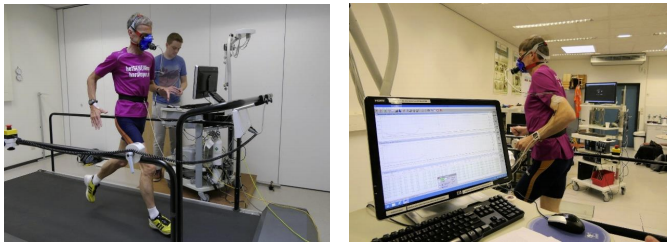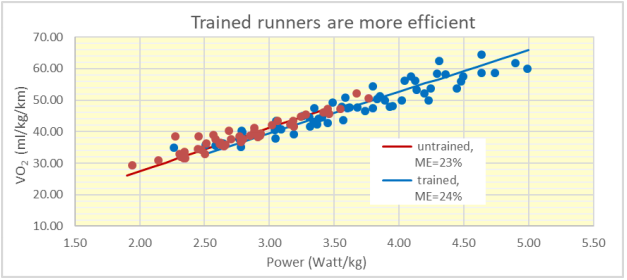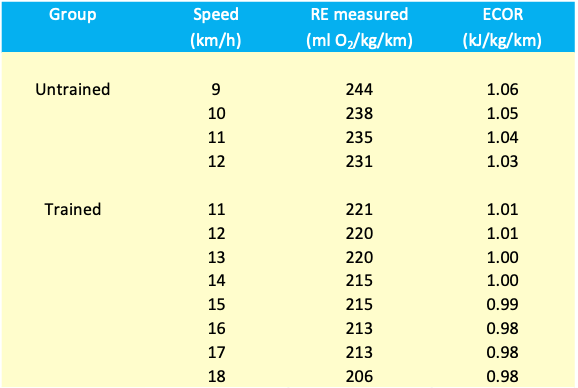The physiological differences between trained and untrained runners

In our book (www.thesecretofrunning.com) we have described our initial treadmill research on 14 test runners in the physiological laboratory of the Dutch Sports Medical Center SMA Midden Nederland. We were quite impressed by the results which showed that the Stryd power data closely correlated to the VO2, which has always been considered as the gold standard in physiological research.
Recently, we have carried out a new research project in cooperation with the physiological laboratory of prof. Maria Hopman at the Radboud University of Nijmegen (RUN), the Netherlands. A full scientific paper on the project has been submitted to the Journal of Sports Sciences and Medicine. In order to share our results with the running community at large, we have written 4 short popular papers (numbered 24-27) on the main findings:
1. The (close) relationship between Stryd power and VO2
2. The impact of speed on the running economy (ECOR and RE)
3. The impact of cadence on the running economy (ECOR and RE)
4. The physiological differences between trained and untrained runners
This paper is the fourth of this series. The pictures below show the authors during the treadmill tests as well as some of the laboratory equipment at RUN. The left picture also shows the primary investigator, MSc-student Rick Sniekers.

Big differences between trained and untrained runners
The project included measuring the VO2 (in ml O2/kg/min) and Stryd power (in Watt/kg) of 21 runners (11 trained and experienced distance runners and 10 untrained students) at 5 different speeds (maintained during 3 minutes and increased in 4 steps of 1 km/h up to lactate threshold) and cadences (self-selected cadence and 10 steps per minute higher cadence and 10 spm lower cadence at a lactate threshold speed minus 2 km/h). This means that we got a total of 21*8 = 168 data of VO2 and power. The most striking result was that we found significant and consistent differences between the trained runners and the untrained runners. These differences will be elucidated in the following paragraphs.
Trained runners need less oxygen (some 4%) to produce the same Wattage
We have found that trained runners have a somewhat lower VO2 (in ml O2/kg/min) at the same power (in Watt/kg), see the figure below.

This means that the Metabolic Efficiency (ME) of trained runners must be higher. In our book, we have derived the following relationship:
ME = Mechanical power/ Metabolic power = P/(VO2/60*EY)
The EY is the energy yield of oxygen which can be approximated at 19 J/ml O2. As an example, we use a VO2 of 50, an EY of and a P of 3.5 Watt/kg, the result is an ME of 0.22 or 22%. The figure shows that the untrained runners had an ME of around 23%, whereas the trained runners were more efficient with an ME of around 24% (this means they need 4% less oxygen to produce the same amount of power).
We assume that this improved Metabolic Efficiency is the result of many years of training and the gradual improvement of many physiological functions in the body of the runner (energy production in the cells, heart-lung system, muscle strength etc.). We believe elite athletes may even have an ME up to the theoretical maximum of 25%, so they need even less oxygen.
Trained runners need less energy per km, their Energy Cost of Running (ECOR) is 5% lower
From the power data, we calculated the Energy Cost of Running (ECOR) with the formula:
ECOR (kJ/kg/km) = P (Watt/kg)/v (m/s)
As an example we use a P of 3.4 and a speed of 12 km/h (3.33 m/s), so the ECOR is 3.5/3.33= 1.02 kJ/kg/km.
As shown in the table below, we found that the average ECOR of trained runners was 0.99 kJ/kg/km or 5% lower than the average ECOR of untrained runners (1.04). We assume that this is the direct result of the better running technique that the trained runners have developed in many years of training.

Trained runners need less oxygen per km, their Running Economy (RE) is 10% lower
From the VO2 data we calculated the oxygen cost of running, commonly referred to as the Running Economy (RE) with the formula:
RE (mlO2/kg/km) = 60/3.6*VO2 (ml O2/kg/min)/v (m/s)
As an example we use a VO2 of 45 and a speed of 12 km/h (3.33 m/s), so the RE is 60/3.6*45/3.3= 225 ml O2/kg/km.
As shown in the table above, we found that the average RE of trained runners was 215 ml O2/kg/km or 10% lower than the 237 ml O2/kg/km of untrained runners. Above, we already noted that the ME of our trained runners was higher than that of the untrained runners (24% vs 23% or a relative increase of 4%). This explains the discrepancy between the 10% difference in RE as compared to the 5% difference in ECOR of the two groups.
Conclusions
In our research we found a significant and consistent difference between the trained runners and the untrained runners. The results of the trained runners were superior in various aspects:
1. They needed 5% less mechanical energy (ECOR 0.99 vs 1.04)
2. They needed 10% less oxygen (RE 215 vs 237)
3. Their metabolic efficiency (ME) was 4% higher (24% vs 23%)
These results confirm our earlier findings that the Stryd power data and in particular the ECOR can be used very well to optimize training and running technique on a daily basis. Improvements in training should lead to both lower energy cost (ECOR) as well as oxygen cost (RE) of running at a certain speed.
If you would like to purchase The Secret of Running (or the German version, Das Geheimnis des Laufens), you can do so at the bottom of store.stryd.com.

